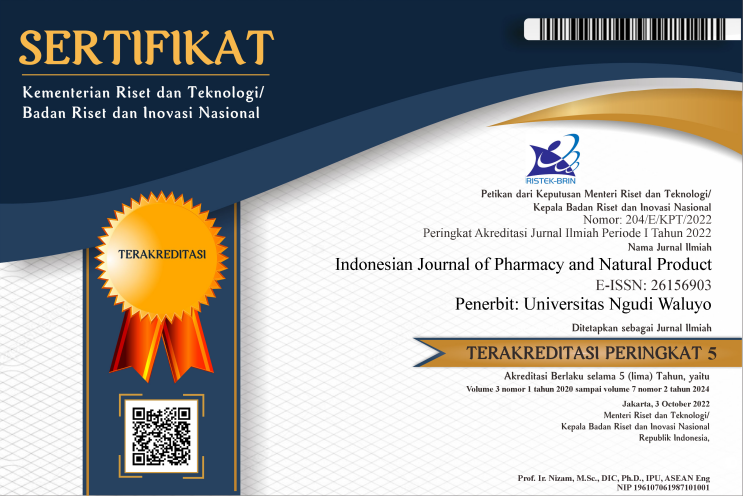Aktivitas Quercetin sebagai Penghambat Sar-Cov2 Kajian Molekular Docking pada 3CLpro, PLpro, DAN NSP3.
DOI:
https://doi.org/10.35473/ijpnp.v5i2.1789Keywords:
quercetin, PLpro, 3CLpro, NSP3, SAR-Cov-2.Abstract
The COVID-19 outbreak is proving to be a worldwide disaster and there is no specific antiviral treatment recommended for COVID-19. Efforts to develop new, broad-spectrum, low-toxicity inhibitors are urgently needed. This study aimed to analyze the binding affinity of quercetin on 3CLpro, PLpro and NSP3 proteins. In silico research by modeling Quercetin as a candidate compound or drug for the Covid-19 antiviral (SARS-CoV-2) evaluated for its binding affinity to 3CLpro, PLpro and NSP3 proteins in computational chemistry using PLANTS and YASARA software. Results: The tethering affinity in our study for the target proteins 3CLpro, PLpro and NSP3, RMSD: -70.3590; -79.1524; and -87.3134 respectively were less than 2 Ȁ which indicated they had potential as drug candidates. Quercetin has the potential to be developed as a candidate for SAR-CoV-2 inhibitor, and this compound can be obtained from a variety of ethnopharmacology that is widely grown and has been used empirically for generations by the Indonesian people.
ABSTRAK
Wabah COVID-19 terbukti menjadi bencana melanda seluruh dunia dan belum ada pengobatan antivirus khusus yang direkomendasikan untuk COVID-19. Upaya pengembangan inhibitor baru, spektrum luas, dengan toksisitas rendah sangat dibutuhkan. Penelitian ini bertujuan untuk menganalisis afinitas docking quercetin pada 3CLpro, PLpro dan NSP3. Penelitian in silico dengan pemodelan quercetin sebagai senyawa atau kandidat obat antivirus Covid-19 (SARS-CoV-2) yang dievaluasi afinitas docking pada 3CLpro, PLpro dan NSP3 secara kimia komputasi menggunakan software PLANTS dan YASARA. Hasil: Afinitas docking dalam penelitian kami terhadap protein target 3CLpro, PLpro dan NSP3 masing-masing RMSD: 70,3590; -79,1524, dan -87,3134 kurang dari 2 Ȁ yang menunjukkan memiliki potensi sebagai kandidat obat. Quercetin berpotensi dapat dikembangkan sebagai kandidat inhibitor SAR-CoV-2, dan senyawa ini dapat diperoleh dari berbagai etnofarmakologi yang banyak tumbuh dan telah digunakan secara empiris turun temurunan oleh masyarakat Indonesia.
References
Freitas, B. T., Durie, I. A., Murray, J., Longo, J. E., Miller, H. C., Crich, D., Hogan, R. J., et al, (2020). Characterization and Noncovalent Inhibition of the Deubiquitinase and deISGylase Activity of SARS-CoV-2 Papain-Like Protease. ACS Infect. Dis, 6(8), 2099“2109. https://doi.org/10.1021/acsinfecdis.0c00168
Centers for Disease Control and Prevention (2019) Novel Coronavirus, Wuhan, China. 2020. Available online: https://www.cdc.gov/coronavirus/2019-ncov/prevent-getting-sick/prevention.html (accessed on 13 April 2020).
Cho, C.C., Lin, M. H., Chuang, C. Y., & Hsu, C. H. (2016). Macro Domain from Middle East Respiratory Syndrome Coronavirus (MERS-CoV) Is an Efficient ADP-ribose Binding Module: Crystal structure and biochemical studies. J. Biol. Chem, 291(10), 4894“4902. https://doi.org/10.1074/jbc.M115.700542
Cinatl, J., Morgenstern, B., Bauer, G., Chandra, P., Rabenau, H., & Doerr, H. W. (2003). Treatment of SARS with human interferons. Lancet (London, England), 362(9380), 293“294. https://doi.org/10.1016/s0140-6736(03)13973-6
Clemente, V., D'Arcy, P., & Bazzaro, M. (2020). Deubiquitinating Enzymes in Coronaviruses and Possible Therapeutic Opportunities for COVID-19. Int. J. Mol. Sci., 21(10), 3492. https://doi.org/10.3390/ijms21103492
Drosten, C., Günther, S., Preiser, W., van der Werf, S., Brodt, H. R., Becker, S., et al, (2020). Flavonoid Glycosides and Their Putative Human Metabolites as Potential Inhibitors of the SARS-CoV-2 Main Protease (Mpro) and RNA-dependent RNA Polymerase (RdRp). Brasil. Int J Mem Inst Oswaldo Cruz, Rio de Janeiro; 115: e200-207. https://doi.org/10.1590/0074-02760200207
Fehr, A.R., & Perlman, S. (2015). Coronaviruses: an overview of their replication and pathogenesis,†in Coronaviruses: Methods and Protocols, eds H. J. Maier, E. Bickerton and P. Britton (New York, NY: Springer New York), 1“23. https://doi.org/10.1007/978-1-4939-2438-7_1
Hsih, W. H., Cheng, M. Y., Ho, M. W., Chou, C. H., Lin, P. C., Chi, C. Y., et al, (2020). Featuring COVID-19 cases via screening symptomatic patients with epidemiologic link during flu season in a medical center of central Taiwan. J. Microbiol. Immunol. Infect. 53(3), 459“466. . https://doi.org/10.1016/j.jmii.2020.03.008
Hu, T., Zhang, Y., Li, L., Wang, K., Chen, S., Chen, J., et al, (2009). Two adjacent mutations on the dimer interface of SARS coronavirus 3C-like protease cause different conformational changes in crystal structure. Virol, 388(2), 324“334. https://doi.org/10.1016/j.virol.2009.03.034
Jain, A. N. (2006). Scoring functions for protein-ligand docking. Current protein & peptide science, 7(5), 407“420. https://doi.org/10.2174/138920306778559395.
Jin, Z., Zhao,Y, Sun, Y., Zhang, B., Wang, H., Wu, Y., et al, (2020). Structural Basis for the Inhibition of SARS-CoV-2 main Protease by Antineoplastic drug carmofur. J. Nat Struct Mol Biol. https://doi.org/10.1038/s41594-020-0440-6.
Kemp M. (2016). Recent Advances in the Discovery of Deubiquitinating Enzyme Inhibitors. Prog.Med. Chem., 55, 149–192. https://doi.org/10.1016/bs.pmch.2015.10.002
Lei, J., Kusov, Y., & Hilgenfeld, R. (2018). Nsp3 of coronaviruses: Structures and functions of a large multi-domain protein. J. Antiviral Res, 149, 58“74. https://doi.org/10.1016/j.antiviral.2017.11.001
Lensink, M. F., Mndez, R., & Wodak, S. J. (2007). Docking and scoring protein complexes: CAPRI 3rd Edition. Proteins, 69(4), 704“718. https://doi.org/10.1002/prot.21804
Liang P.H. (2006). Characterization and inhibition of SARS-coronavirus main protease. Curr. Top. Med. Chem., 6 (4) , 361–376. https://doi.org/10.2174/156802606776287090
Lung, J., Lin, Y. S., Yang, Y. H., Chou, Y. L., Shu, L. H., Cheng, Y. C., et al, (2020). The potential chemical structure of anti-SARS-CoV-2 RNA-dependent RNA polymerase. J. Med. Virol, 92(6), 693“697. https://doi.org/10.1002/jmv.25761
Makrynitsa, G.I., Ntonti, D., Marousis, K.D., Birkou, M., Matsoukas, M. T., Asami, S., et al, (2019). Conformational plasticity of the VEEV macro domain is important for binding of ADP-ribose. J. Struc Biol, 206(1), 119–127. https://doi.org/10.1016/j.jsb.2019.02.008
Mielech, A. M., Deng, X., Chen, Y., Kindler, E., Wheeler, D. L., Mesecar, A. D., et al, (2015). Murine coronavirus ubiquitin-like domain is important for papain-like protease stability and viral pathogenesis. J. Virol, 89(9), 4907“4917. https://doi.org/10.1128/JVI.00338-15
Omrani, A. S., Saad, M. M., Baig, K., Bahloul, A., Abdul-Matin, M., Alaidaroos, A. Y., et al, (2014). Ribavirin and interferon alfa-2a for severe Middle East respiratory syndrome coronavirus infection: a retrospective cohort study. Lancet. Infec. Dis, 14(11), 1090“1095. https://doi.org/10.1016/S1473- 3099(14)70920-X
Park, J.Y., Yuk, H.J., Ryu, H.W., Lim, S.H., Kim, K.S., Park, K.H., et al, (2017). Evaluation of polyphenols from Broussonetia papyrifera as coronavirus protease inhibitors. J. Enzyme Inhib. Med. Chem. 32(1), 504“515. https://doi.org/10.1080/14756366.2016.1265519
Park, J.Y., Kim, J.H., Kim, Y.M., Jeong, H.J., Kim, D. W., Park, K. H., et al, (2012). Tanshinones as selective and slow-binding inhibitors for SARS-CoV cysteine proteases. Bioorg. Med. Chem, 20(19), 5928–5935. https://doi.org/10.1016/j.bmc.2012.07.038
Purnomo, H., 2013. Kimia Komputasi Untuk Farmasi dan Ilmu Terkait “ Uji In Silico Senyawa Antikanker, Pustaka Pelajar. Yogyakarta.
Rabi, F. A., Al Zoubi, M. S., Kasasbeh, G. A., Salameh, D. M., & Al-Nasser, A. D. (2020). SARS-CoV-2 and Coronavirus Disease 2019: What We Know So Far. Pathogens (Basel, Switzerland), 9(3), 231. https://doi.org/10.3390/pathogens9030231
Rabenau, H., Panning, M., Kolesnikova, L., Fouchier, R. A., Berger, A., Burguie, A. M., et al, (2003). Identification of a novel coronavirus in patients with severe acute respiratory syndrome. N Engl. Med, 348(20), 1967“1976. https://doi.org/10.1056/NEJMoa030747
Robertson, T.A., & Varani, G. (2007). An all-atom, distance-dependent scoring function for the prediction of protein-DNA interactions from structure. Proteins, 66(2), 359“374. https://doi.org/10.1002/prot.21162
Santiago, D.N., Pevzner, Y., Durand, A.A., Tran, M., Scheerer, R. R., Daniel, K., et al, (2012). Virtual target screening: validation using kinase inhibitors. J. Chem. Inf. Model, 52(8), 2192-2203. https://doi.org/10.1021/ci300073m.
Scior, T., Bender, A., Tresadern, G., Medina-Franco, J. L., MartÃnez-Mayorga, K., Langer, T., et al, (2012). Recognizing pitfalls in virtual screening: a critical review. J. Chem. Inf. Model, 52(4), 867“881. https://doi.org/10.1021/ci200528d
Septiana, E. 2020. Prospek Senyawa Bahan Alam Sebagai Antivirus Dalam Menghambat SARS-CoV-2. Pusat Penelitian Bioteknologi “ LIPI. J BioTrends Vol.11 No.1 Tahun 2020.
St John, S. E., Therkelsen, M. D., Nyalapatla, P. R., Osswald, H. L., Ghosh, A. K., & Mesecar, A. D. (2015). X-ray structure and inhibition of the feline infectious peritonitis virus 3C-like protease: Structural implications for drug design. Bioorg. Med. Chem. Lett, 25(22), 5072“5077. https://doi.org/10.1016/j.bmcl.2015.10.023
Wang, H., Wang, S., & Yu, K. (2020). COVID-19 infection epidemic: the medical management strategies in Heilongjiang Province, China. Critical care (London, England), 24(1), 107. https://doi.org/10.1186/s13054-020-2832-8
World Health Organization Novel Coronavirus (2019-nCoV), Situation Report 1. 21 January 2020. https://www.who.int/docs/default-source/coronaviruse/situation-reports/20200121-sitrep-1-2019 ncov.pdf (accessed on 25 March 2020)
Wu, C., Liu, Y., Yang, Y., Zhang, P., Zhong, W., Wang, Y., et al, (2020). Analysis of therapeutic targets for SARS-CoV-2 and discovery of potential drugs by computational methods. J Acta Pharmaceut Sin. B, 10(5), 766–788. https://doi.org/10.1016/j.apsb.2020.02.008
Yang, D., & Leibowitz, J. L. (2015). The structure and functions of coronavirus genomic 3' and 5' ends. Virus research, 206, 120“133. https://doi.org/10.1016/j.virusres.2015.02.025
Zhang, H., Penninger, J.M., Li, Y., Zhong, N., & Slutsky, A.S. (2020). Angiotensin-converting enzyme 2 (ACE2) as a SARS-CoV-2 receptor: molecular mechanisms and potential therapeutic target. Inten Care Med, 46(4), 586“590. https://doi.org/10.1007/s00134-020-




